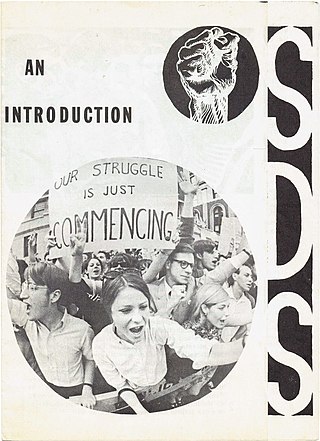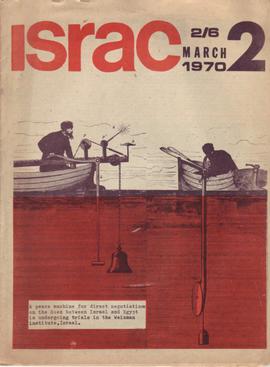Related Research Articles

The Weather Underground was a far-left militant organization first active in 1969, founded on the Ann Arbor campus of the University of Michigan. Originally known as the Weathermen, the group was organized as a faction of Students for a Democratic Society (SDS) national leadership. Officially known as the Weather Underground Organization (WUO) beginning in 1970, the group's express political goal was to create a revolutionary party to overthrow the United States government, which WUO believed to be imperialist.
The Revolutionary Socialist League (RSL) was a Trotskyist group in the United States established circa 1972 and disbanded 1989.

The Freedom Road Socialist Organization (FRSO) is a Marxist–Leninist organization in the United States. It formed in 1985 amid the collapse of the Maoist-oriented New Communist movement that emerged in the 1970s.
The New Communist movement (NCM) was a diverse left-wing political movement principally within the United States, during the 1970s and 1980s. The NCM were a movement of the New Left that represented a diverse grouping of Marxist–Leninists and Maoists inspired by Cuban, Chinese, and Vietnamese revolutions. This movement emphasized opposition to racism and sexism, solidarity with oppressed peoples of the third-world, and the establishment of socialism by popular revolution. The movement, according to historian and NCM activist Max Elbaum, had an estimated 10,000 cadre members at its peak influence.

Noel Ignatiev was an American author and historian. He was best known for his theories on race and for his call to abolish "whiteness". Ignatiev was the co-founder of the New Abolitionist Society and co-editor of the journal Race Traitor, which promoted the idea that "treason to whiteness is loyalty to humanity". In 1995 he published the book, How the Irish Became White, an examination of the choices made by early Irish Immigrants to the United States, many of whom, when faced with xenophobia and a history of being oppressed themselves, proceeded to take the opportunity to increase their power in society by identifying as "white" and participating in oppressing darker-skinned peoples.
The Chicago Women's Liberation Union (CWLU) was an American feminist organization founded in 1969 at a conference in Palatine, Illinois.
The League of Revolutionary Struggle (Marxist–Leninist) was a Marxist–Leninist[1] movement in the United States formed in 1978 by merging communist organizations. It was dissolved by the organization's leadership in 1990.
The Combahee River Collective was a Black feminist lesbian socialist organization active in Boston from 1974 to 1980. The Collective argued that both the white feminist movement and the Civil Rights Movement were not addressing their particular needs as Black women and, more specifically, as Black lesbians. Racism was present in the mainstream feminist movement, while Delaney and Manditch-Prottas argue that much of the Civil Rights Movement had a sexist and homophobic reputation.
Scott Braley was a leftist activist and a regional organizer for the Michigan State University's chapter of the Students for a Democratic Society, better known as SDS. Braley became a member of Weatherman in 1969 and remained so until the group disbanded in 1977. Braley was one of the original members of the Revolutionary Youth Movement, a group devoted to anti-racism and Third World struggles which later evolved into Weatherman.

The Prairie Fire Organizing Committee is an American far left organization that evolved from the Weather Underground.

Osawatomie was a magazine published by the Weather Underground Organization (WUO), beginning in March 1975 and continuing for six issues until the June-July 1976 issue. It was started as a quarterly publication, but from the April/May 1976 issue its frequency became bimonthly. The magazine was based in Boston.

In the United States, the Revolutionary Youth Movement (RYM) is the section of Students for a Democratic Society (SDS) that opposed the Worker Student Alliance of the Progressive Labor Party (PLP). Most of the national leadership of SDS joined the RYM in order to oppose PLP's party line and what they alleged to be its attempted takeover of the SDS leadership structure, particularly at the 1969 SDS convention in Chicago.

Students for a Democratic Society (SDS) was a national student activist organization in the United States during the 1960s, and was one of the principal representations of the New Left. Disdaining permanent leaders, hierarchical relationships and parliamentary procedure, the founders conceived of the organization as a broad exercise in "participatory democracy". From its launch in 1960 it grew rapidly in the course of the tumultuous decade with over 300 campus chapters and 30,000 supporters recorded nationwide by its last national convention in 1969. The organization splintered at that convention amidst rivalry between factions seeking to impose national leadership and direction, and disputing "revolutionary" positions on, among other issues, the Vietnam War and Black Power.

Guevarism is a theory of communist revolution and a military strategy of guerrilla warfare associated with Marxist–Leninist revolutionary Ernesto "Che" Guevara, a leading figure of the Cuban Revolution who believed in the idea of Marxism–Leninism and embraced its principles.

Matzpen is the name of a revolutionary socialist and anti-Zionist organisation, founded in Israel in 1962 which was active until the 1980s. Its official name was the Socialist Organisation in Israel, but it became better known as Matzpen after its monthly publication.
Wei Min She developed in the 1970s as an anti-imperialist organization in the San Francisco Bay area. When WMS first formed, many members identified themselves as Marxists and the group consisted of many different groups of people. They were primarily the working class, students and bourgeois.
Revolutionary Action Movement (RAM) was a US-based revolutionary black nationalist group in operation from 1962 to 1969. They were the first group to apply the philosophy of Maoism to conditions of black people in the United States and informed the revolutionary politics of the Black Power movement. RAM was the only secular political organization which Malcolm X joined prior to 1964. The group's political formation deeply influenced the politics of Huey Newton, Bobby Seale, and many other future influential Black Panther Party founders and members.
The 1969 Students for a Democratic Society National Convention held in June of that year in Chicago, Illinois was the final convention held by the Students for a Democratic Society (SDS). The gathering, which took place over June 18–22, was one of four conventions officers and members of SDS attended each year. Taking place at the Chicago Coliseum, the convention was the site of chaos and tension, with members breaking into factions, each vying for control of the organization. Prior to this convention, one of the factions, the Revolutionary Youth Movement (RYM), soon to be renamed the Weathermen, wrote a manifesto regarding the ways and means by which to take SDS in the years to come. The creation of the Weathermen, from RYM, was essentially the main reason for the functioning, and later the disintegration, of SDS. Leading members of the college-based organization wanted to push its boundaries in order to create real revolution and change in America. The SDS National Convention of June 1969 was the culmination of all disagreement within its membership. The result of the convention was a disoriented and gutted organization, complete in only its name.
Michael Goldfield is an American political scientist, author, labor activist, and former student activist. He is an emeritus professor of industrial relations and human resources in the department of political science at Wayne State University in Detroit, Michigan, and a faculty associate at the Harry Bridges Center for Labor Studies at the University of Washington.
The Tricontinental Conference was a gathering of countries that focused on anti-colonial and anti-imperial issues during the Cold War era, specifically those related to Africa, Asia, and Latin America. The conference was held from 3rd to 16 January 1966, in Havana, Cuba and was attended by roughly 500 delegates from 82 different countries. It founded the Organization of Solidarity with the People of Asia, Africa and Latin America (OSPAAAL). The key issues discussed at the conference were countries that were in midst of revolutions, with a specific focus on Cuba and Vietnam.
References
- ↑ "Preface to Workplace Papers (1980)" . Retrieved 2018-04-06.